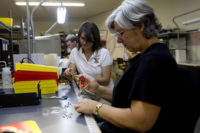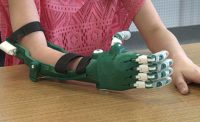Automotive engineers have been intrigued with additive manufacturing for more than a decade. That’s because the technology offers numerous benefits, such as the ability to rapidly create physical parts, consolidate multiple components or assemblies into one part, and test the fit or function of parts before mass production.
One automaker at the forefront of 3D printing is General Motors. The company recently opened a 4,000-square-foot Additive Innovation Lab at its tech center in Warren, MI. And, later this year, GM plans to open an Additive Industrialization Center in the same R&D complex.
GM engineers are using 3D printing to launch new vehicles, such as the mid-engine Chevrolet Corvette.
“3D printing helps us design and build parts and products faster and in ways we previously couldn’t,” says Kevin Quinn, director of additive design and manufacturing at GM. “It’s already having a positive impact on how we develop and build vehicles.”
For instance, the first time a physical version of the mid-engine Corvette came together, 75 percent of the parts were printed. The technology was also used extensively to test and implement features like right-hand drive for international markets and the retractable hardtop.
“No other GM slow-build design and engineering evaluation has featured this amount or level of detail in terms of its 3D-printed components,” claims Quinn. “This allowed the team to envision what a production vehicle would look like and how all the parts would fit together. They were also able to diagnose and correct issues early on, reducing development time.”
BMW is another automaker that envisions a bright future for 3D printing. Last year, it printed 300,000 parts. BMW has invested in companies such as Carbon, Desktop Metal and Xometry. It also recently opened an Additive Manufacturing Campus in Munich, Germany, to develop new production processes and applications.
“Additive manufacturing is already an integral part of our worldwide production system today, and established in our digitalization strategy,” says Daniel Schafer, senior vice president for production integration and pilot plant at BMW. “In the future, new technologies of this kind will shorten production times even further and allow us to benefit even more fully from the potential of toolless manufacturing.
“Our goal is to industrialize 3D printing methods more and more for automotive production, and to implement new automation concepts in the process chain,” explains Schafer. “This will allow us to streamline component manufacturing for series production and speed up development.
“At the same time, we are collaborating with vehicle development, component production, purchasing and [our] supplier network to systematically integrate the technology and utilize it effectively,” adds Schafer.
BMW engineers are also involved in several collaborative R&D projects, such as IDAM and POLYLINE, with other German organizations. The goal is to develop next-generation assembly lines that incorporate additive manufacturing.
“With IDAM, BMW and its 12 project partners are paving the way for the integration of additive manufacturing into series production environments within the automotive industry,” says Schafer. “At the Additive Manufacturing Campus, a production line is being set up that replicates the entire process chain, from the preparation of digital production through to manufacture and reworking of components.”
The POLYLINE project is focusing on mass-production of plastic parts. Engineers are attempting to digitally link process steps and develop consistent quality procedures for the entire process chain.
“The Additive Manufacturing Campus will provide the backdrop for the project’s consortium of 15 partners to develop and test a future-proof, fully linked, automated production line for plastic components,” explains Schafer. “Findings from the project are expected to help reduce manufacturing costs by as much as 50 percent, making a vital contribution to series production. In addition, integrated quality assurance methods will increase the stability of technologies and make manufacturing more sustainable.”








